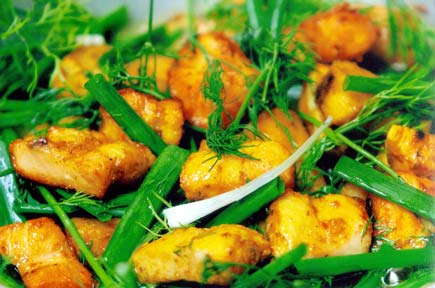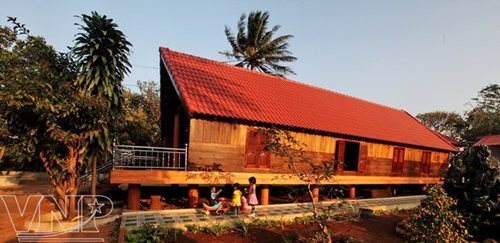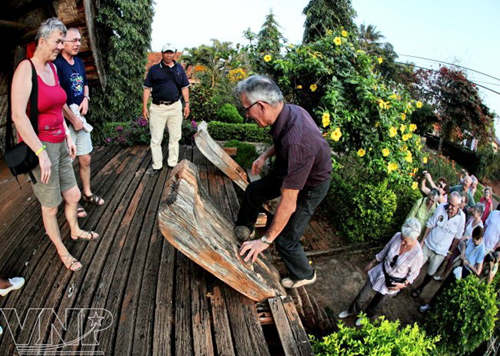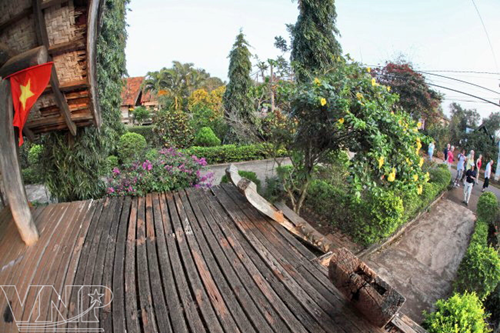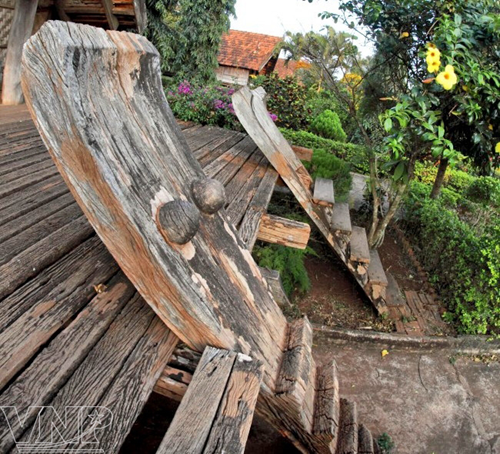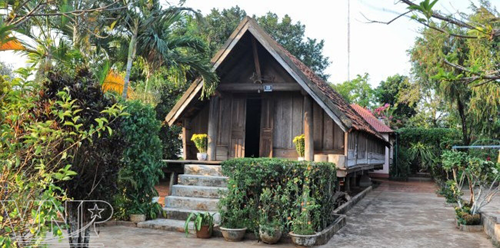Globalgrasshopper, a popular site for international tourists, has listed the top ten must-see destinations in Vietnam.
1. Son Tra Peninsula

Son
Tra Peninsula, about 10km from the central city of Danang, is a special
gift of the god to Danang. It is an ideal place for tourists to
travel to Vietnam's city to get away for the day and enjoy the real feeling of a different Vietnam.
Son
Tra looks like a mushroom of which the cap is Son Tra Mountain and
stalk is a beautiful sandy beach that affords an ideal area for bathing,
swimming, playing sports and fishing.
Son Tra acts as a giant
screen protecting Danang from storms and cyclones coming from the sea.
Son Tra is put under the national protected forest regulation since it
is a natural preservation area.
The peninsula is famous for its
plentiful plants and fauna as well as the attractive scenery. It is said
that fairies used to come here for singing, dancing and playing chess,
so Son Tra is also called Tien Sa.
On this mountain, there still
remain more than 30km² of natural forests, nearly 300 types of plants
and several hundred kinds of fauna, including rare animal. From the top
of the mountain, you can get a panoramic view of Danang City, Marble
Mountains, Ba Na – Mount Chua.
Suoi Da (Stone Stream) lies by the
side of the mountain, fine sandy surfaces run round the peninsula,
several breaks of waves are running steadily up and down and washing up
on the stones heaped up around the seaside. All are attractive spots for
tourists. It is so majestic, so romantic, so wide and really beautiful.
2. Royal tombs of Nguyen dynasty

The Nguyen Dynasty (1802-1945) is the last of the
Vietnamese
dynasties. In total, there were 13 emperors, only seven of which had
tombs however: Gia Long, Minh Mang, Thieu Tri, Tu Duc, Duc Duc, Dong
Khanh and Khai Dinh.
The seven imperial tombs are located in a
hilly region southwest of the Citadel. The tombs of Minh Mang, Tu Duc,
Dong Khanh and Khai Dinh belong to the major touristic destinations in
Hue.
Each of the tombs was constructed during the reign of the
emperor it was named after. All the tombs are equipped with statues and
monuments in perfect Feng Shui harmony to create a natural setting, in
the architecture of which the respective emperor's philosophical
tendencies are often reflected.
The general elements incorporated
in all the tombs are: walls, triple gate (Tam Quan Gate), Salutation
Court, Stele House, temples, lakes and ponds, pavilions, gardens, and
finally the tomb.
King Khai Dinh tomb is considered the most beautiful.
3. Phu Quoc Island

Phu
Quoc is part of the southern province of Kien Giang province. The
island is 50 km long (from north to south) and 25 km wide (from east to
west at its widest part).
Surrounded by more than 40 km of white beaches decorated with coconut palms, Phu Quoc is
Vietnam’s
largest island. Its western coastline is sparsely populated while the
interior is largely covered with jungle and mainly deserted.
A stay on Phu Quoc Island would not be complete without visiting one of the factories producing
nuoc mam (fish
sauce), one of the most popular ingredients of the Vietnamese cooking
as well as one of the pearl farms with panels describing the formation
of pearls and shops selling pearl jewelry.
The island has a unique
species of dogs, the Phu Quoc ridgeback, which has a ridge of hair that
runs along its back in the opposite direction to the rest of the coast.
Much of this island’s nature is still protected.
Around 70
percent of the island, an area of 31,422 hectares, became a national
park in 2001. The rainy season on Phu Quoc is from July to November and
the peak season for tourism is midwinter, when the sky is blue and the
sea is calm.
4. The Mekong Delta

The Mekong Delta is the region in southwestern
Vietnam where the Mekong River approaches and empties into the sea through a network of distributaries.
The
Mekong delta region encompasses a large portion of southwestern Vietnam
of 39,000 square kilometers. It has recently been dubbed as a
'biological treasure trove.' Over 10,000 new species have been
discovered in previously unexplored areas of Mekong Delta.
The
region lies immediately to the west of Ho Chi Minh City, roughly forming
a triangle stretching from My Tho in the east to Chau Doc and Ha Tien
in the northwest, down to Ca Mau and the East Sea at the southernmost
tip of Vietnam.
It displays a variety of physical landscapes,
ranging from mountains and highlands to the north and west to broad,
flat flood plains in the south.
This diversity of terrain was
largely the product of tectonic uplift and folding brought about by the
collision of the Indian and Eurasian tectonic plates about 50 million
years ago.
The soil of the Mekong River basin consists mainly of
sediment, deposited over thousands of years as the river changed its
course due to the flatness of the low-lying terrain.
Coming to the delta, visitors will discover the daily life of local people and diverse landscape.
5. Tram Ton Pass (Heaven Gate)

Tram Ton Pass is Vietnam’s highest mountain pass. On a clear day, the view is spectacular.
Don’t
be deterred by mist in Sapa. Conditions on the pass are frequently
different to those in town. The temperature can also rise quite a bit on
the pass as you break away from the cooler air of Sapa.
Thach
Bac (Silver) waterfalls are a compulsory stop for local tour groups and
can be pretty busy. The falls are beautiful but probably only warrant a
visit if time permits and in conjunction with a visit to Tram Ton Pass
3km further along the road.
6. Phong Nha-Ke Bang National Park

Phong
Nha-Ke Bang is a national park and UNESCO World Heritage Site in the
central province of Quang Binh, about 500 km south of Hanoi.
The
park is noted for its cave and grotto systems as it is composed of 300
caves and grottos with a total length of about 70 km, of which only 20
have been surveyed by Vietnamese and British scientists; 17 of these are
located in the Phong Nha area and three in the Ke Bang area.
After
April 2009, the total length of caves and grottoes is 126 km. Before
the discovery of Son Doong Cave, Phong Nha held several world cave
records, as it has the longest underground river, as well as the largest
caverns and passageways.
The park derives its name from Phong Nha
Cave, containing many fascinating rock formations, and Ke Bang forest.
The plateau on which the park is situated is probably one of the finest
and most distinctive examples of a complex karst landform in Southeast
Asia.
This national park was listed in UNESCO's World Heritage
Sites in 2003 for its geological values. The world's largest cave, was
discovered by a team of British cave explorers in April 2009.
7. Ha Long Bay
 Halong Bay
Halong Bay
is a UNESCO World Heritage Site, and a popular travel destination,
located in Quang Ninh province. The bay features thousands of limestone
karsts and isles in various sizes and shapes.
Ha Long Bay has an area of around 1,553 km
2, including 1,960–2,000 islets, most of which are limestone. The core of the bay has an area of 334 km
2 with a high density of 775 islets.
The
limestone in this bay has gone through 500 million years of formation
in different conditions and environments. The evolution of the karst
there has taken 20 million years under the impact of the tropical wet
climate.
The geo-diversity of the environment in the area has
created biodiversity, including a tropical evergreen biosystem, oceanic
and sea shore biosystem. Ha Long Bay is home to 14 endemic floral
species and 60 endemic faunal species.
Historical research surveys have shown the presence of prehistorical human beings in this area tens of thousands years ago.
The
successive ancient cultures are the Soi Nhu culture around 18,000–7,000
BC, the Cai Beo culture 7,000–5,000 BC and the Ha Long culture
5,000–3,500 years ago.
Halong Bay also marked important events in the history of Vietnam with many artifacts found in Bai Tho Mout, Dau Go Cave and Bai Chay.
In 1994, the core zone of Ha Long Bay was listed by UNESCO as a World Heritage Site, and listed for a second time.
8. One-pillar pagoda

One
Pillar Pagoda is a historic Buddhist temple in Hanoi. It is regarded
alongside Perfume Pagoda, as one of Vietnam's two most iconic places of
worship.
The pagoda was built by King Ly Thai Tong, who ruled from
1028 to 1054. According to the court records, the king was childless
and dreamt that he met the bodhisattva Avalokiteshvara, who handed him a
baby son while seated on a lotus flower.
The King then married a
peasant girl that he had met and she bore him a son. He constructed the
pagoda in gratitude for this in 1049 by erecting a pillar in the middle
of a lotus pond, similar to the one he saw in the dream.
The
structure was built of wood on a single stone pillar 1.25 m in diameter,
and it was designed to resemble a lotus blossom, which is a Buddhist
symbol of purity, since a lotus blossoms in a muddy pond.
In 1954, the French Union forces destroyed the pagoda before withdrawing from Vietnam, it was rebuilt afterwards.
9. Da Dia Rapids

Da Dia (Stone Plate) Rapids are located in Tuy An District, the south central province of Phu Yen.
With
strange rock formations, foamy rapids, a fissure with multi-colored
fish and a deep cave, Da Dia Rapids was listed as a National Heritage
Site by the former Ministry of Culture and Information, now the Ministry
of Culture, Sports and Tourism.
Da Dia Rapids is a baffling and
beautiful riddle of nature, and set in stone for all time. It’s like a
giant jigsaw, irritatingly made of the same shaped pieces, and forming a
solidified structure that has proved more than just a curiosity for
thousands.
The stones in Da Dia Rapids are bazan stones of dark
black and light yellow. There are stones of different sizes with
different shapes such as round, pentagon, and polygon and so on.
In
the middle of the rapids, there is a small fissure filled with rain and
sea water. In this fissure, rocks stick out at odd angles. Hence, when
travelling to this area, visitors can also enjoy the fresh air and
refresh after a long drive.
Visiting Da Dia Rapids – you will have the chance to learn about many species of marine creatures, especially jam seaweeds.
10. Hue ancient capital

On December 11, 1993, UNESCO recognized the architectural ensemble of Hue as a World Cultural Heritage site.
That
was the first time a Vietnamese city had ever received such a title.
Hue was the capital of the Nguyen Dynasty (1802-1945), the final feudal
regime of Vietnam.
Situated 638 km to the south of Hanoi, only
with 6,777 hectares in area and 280,000 in population, this historical
ancient capital has become one cultural and tourism center of Vietnam
and the world.
The most amazing thing about Hue is the blend of royal-folk architecture and romantic nature.
This
romance is all evident in the beauty of the Huong River, Ngu Mountain,
chanties and folklore songs, ancient citadels, palaces, temples,
pagodas, ancient garden houses, special cuisine only found in Hue, court
music and dancing, Hue chanties on the Huong (Perfume) River and
especially in the souls of the people here.
Beautiful nature,
ancient architecture, and elegant people are combined together to make
Hue a heaven of poems, music and paintings, and a World Heritage site
that serves as an everlasting inspiration for generations of artists.


